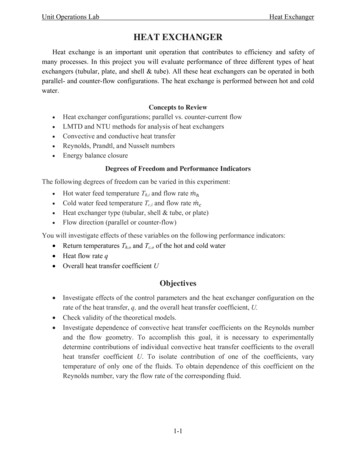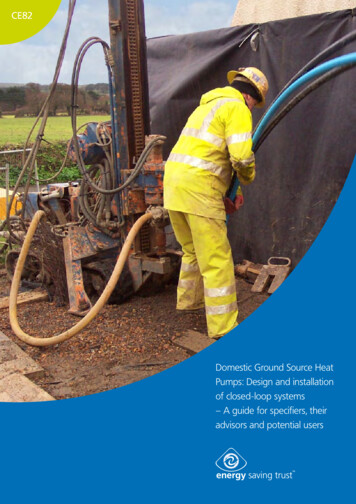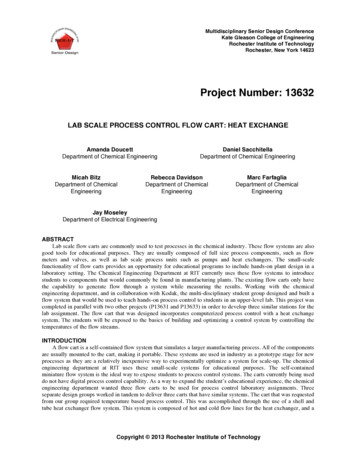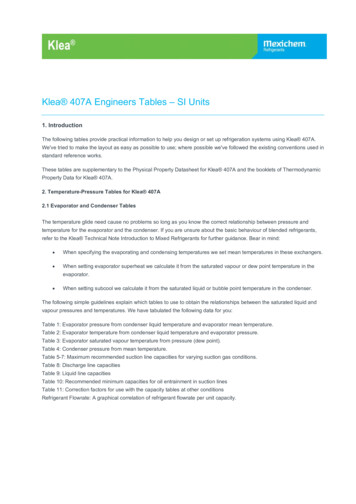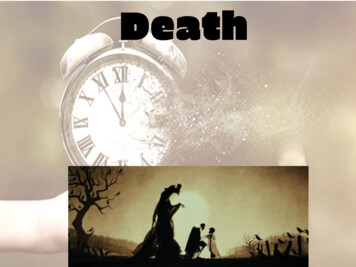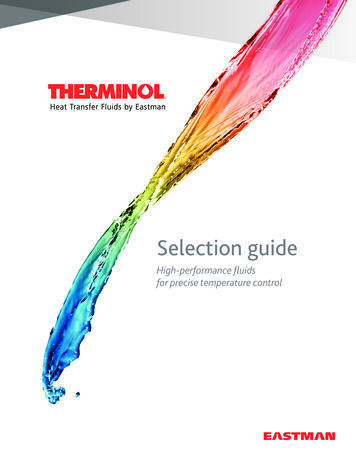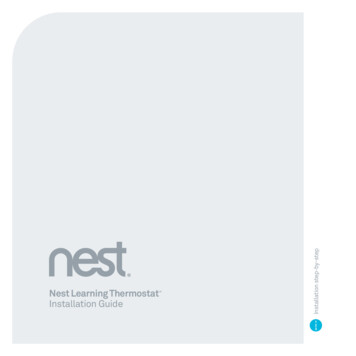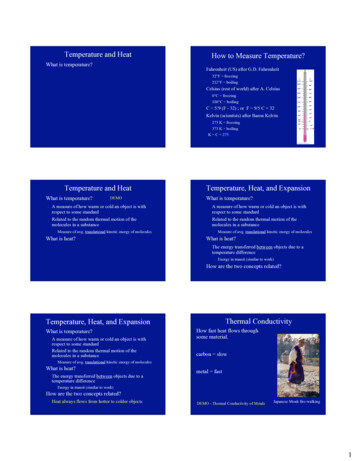
Transcription
Temperature and Heat How to Measure Temperature?What is temperature? Fahrenheit (US) after G.D. Fahrenheit–32 F freezing–212 F boilingCelsius (rest of world) after A. Celsius–0 C freezing–100 C boiling C 5/9 (F - 32) ; or F 9/5 C 32 Kelvin (scientists) after Baron Kelvin–273 K freezing373 K boilingK C 273–Temperature and Heat What is temperature?DEMO What is temperature?–A measure of how warm or cold an object is withrespect to some standard–A measure of how warm or cold an object is withrespect to some standard–Related to the random thermal motion of themolecules in a substance–Related to the random thermal motion of themolecules in a substance Temperature, Heat, and ExpansionMeasure of avg. translational kinetic energy of molecules What is heat? –The energy transferred between objects due to atemperature difference Measure of avg. translational kinetic energy of moleculesWhat is heat?Energy in transit (similar to work)How are the two concepts related?Thermal ConductivityTemperature, Heat, and Expansion What is temperature?––A measure of how warm or cold an object is withrespect to some standardRelated to the random thermal motion of themolecules in a substance The energy transferred between objects due to atemperature difference How fast heat flows throughsome material. carbon slow metal fastMeasure of avg. translational kinetic energy of moleculesWhat is heat?– Energy in transit (similar to work)How are the two concepts related?–Heat always flows from hotter to colder objectsDEMO - Thermal Conductivity of MetalsJapanese Monk fire-walking1
Heat and Internal EnergyHow to Measure Heat?Internal energy –Total energy contained in asubstance –translation, rotational, vibrationalkinetic energiesinterparticle potential energiesWhen an object absorbs (givesoff) heat, its internal energyincreases (decreases)Imagine a red hot thumbtackdropped in a pail of warm water ––SI unit is Joules –4.18 Joules to change 1 gram of water 1 K–1 calorie to change 1 gram of water 1 K–(note 1000 calories 1 Calorie) so 1 peanut contains10 Calories or 10,000 calories–Our bodies metabolize (burn) food to keep us warm,do useful work, or just goof offWhich has more internal energy?Which has more internal energy?In what direction will heat flow?Specific Heat Capacity The quantity of heat neededto raise the temperature ofone gram of a substance by1º Celsius–Measures the resistance of asubstance to temp. changes–Works both ways –Thermal Expansion Why do objects tend toexpand when heated andcontract when cooled?Thermal inertiaSubstances that take longer toheat up also take longer to coolHow does the high specificheat of water affect weather inthe U.S.?Which has a higher specific heat,the filling or the crust?Thermal Expansion Why do objects tend toexpand when heated andcontract when cooled?– As temperature increases,molecules jiggle faster andmove farther apartGolden gate bridge contractsmore than a meter in coldweatherEx. #2 Supportstructure fortelescopes. Ex. Expansion joints inbridges Importantengineeringconsideration–Important engineeringconsideration–Thermal ExpansionVLA dishesexperience pointingoffset if one side iswarmed by the sunand the other side isin the shadeThe unequal expansion of a bimetallicstrip can operate a thermostat.DEMO - Bi-metal strip2
Why Does Ice Float? What must be true of anysubstance in order for itto float in water?Why Does Ice Float? Unlike most materials,H2O expands as it freezes–Ice is less dense thanliquid water flotation–Due to crystallinestructure of ice Greater spacing betweenmolecules than in the liquidphaseDensity of WaterDensity of WaterClicker Question:Clicker Question:Which of the following is not a propertyof matter:Which of the following cannot beexpressed in Joules?A: massA: heatB: temperatureB: kinetic energyC: heatC: temperatureD: internal energyD: work3
Clicker Question:Thermodynamics How is it that people can firewalk and notget burned?The study of heat and itstransformation to mechanicalenergy and work–1st law of thermodynamics A: They consume large amounts of asbestos to developfire-proof feet.B: The coals are not actually very hot.When heat flows into (or out of) asystem, the system gains (or loses)an amount of energy equal to theamount of heat transferred.ΔHeat ΔInternal Energy WorkC: The coals are not efficient at heat transfer (havepoor thermal conductivity).–D: They run above the coals and don’t actually makecontact with them.Adding heat to a system can: increase the internal energy of thesystemenable the system to do externalwork (or both)1st Law (cont.) What fundamental principle in physics does the 1st lawexpress?1st Law (cont.) What fundamental principle in physics does the 1st lawexpress?–Conservation of energy (ΔHeat ΔInternal Energy Work) Holds for all systems, regardless of the specifics of their innerworkingsAdding heat––to fixed volume (sealed container of air) How does the temperature and pressure of the air change? How much work is done? Where does the energy go?to changeable volume (e.g. Piston) What happens to the piston?1st Law (cont.) If we do mechanical work on a system, we can alsoincrease its internal energyDevice demonstrating theconversion of mechanicalenergy to heat energy1st Law (cont.) If we do mechanical work on a system, we can alsoincrease its internal energy–Your hands get warmer if you rub them together–Your hands get warmer if you rub them together–What happens to the air in a bicycle pump as the handleis pushed down?–What happens to the air in a bicycle pump as the handleis pushed down? Air is compressed and temperature (measure of internalenergy) risesYou can always transform mechanical energycompletely into heat, but you can never transformheat completely into mechanical energy!–Directionality to nature of heat flow and energyDEMO - Fire Syringe4
2nd Law of Thermodynamics Imagine two bricks at different temperatures inthermal contact–Imagine two bricks at different temperatures inthermal contact If the hot brick were able to extract heat from the coldbrick, would this violate the 1st law ofthermodynamics?–If the hot brick were able to extract heat from the coldbrick, would this violate the 1st law ofthermodynamics? –No. Not if the cold brick becomes even colder so that thetotal amount of energy is conserved.This sort of behavior is prohibited by the 2nd law ofthermodynamics: Heat never spontaneously flows from a cold object to ahotter object.–Heat can be made to flow in the opposite direction, but only bydoing work on the system or by adding energy from anothersource.Heat Engines Heat disordered energy –random thermal motionIf you open a bottle of perfume, what happens tothe perfume molecules? Alternative statement of 2nd law:–No device is possible whose soleeffect is to transform heatcompletely into work.–There is a maximum efficiency(η 1) for any heat engine - 3rdlaw Depends only on operating temps.––Some heat must always be“wasted” (exhausted to alow temperature reservoir)It is easy to convert work entirely intoheat, e.g., frictionReverse is not possibleη Demo - Stirling EngineThot - TcoldThotEntropy and Disorder 2nd Law – Systems left to themselvesevolve towards states of increasingdisorder–Entropy: Measure of disorder Organized energy (e.g. gasoline) degeneratesto disorganized and less useful energy (heat)Perfume diffuses in a room – goes fromorganized state (all molecules in bottle) tomore disordered state (all throughout room)Defines an “arrow” of time–Some processes are time-irreversibleEntropy and Disorder (cont.)Will the perfumemolecules scatteredthroughout the roomever all spontaneouslyreturn to the bottle?Disordered energy can be changed to ordered energyonly with organizational effort or work input–Work put into refrigeration cycle water freezes (moreordered state)–Gas compressed into a smaller volume requires outsidework to be done on the gas–Living organisms concentrate and organize energy fromfood sources–In each case, the entropy of the system decreases. Dothese examples violate the 2nd law of Thermo?5
Entropy and Disorder (cont.) Disordered energy can be changed to ordered energyonly with organizational effort or work input––––Work put into refrigeration cycle water freezes (moreordered state)Gas compressed into a smaller volume requires outsidework to be done on the gasLiving organisms concentrate and organize energy fromfood sourcesIn each case the entropy of the system decreases. Dothese examples violate the 2nd law of Thermo? 3rd Law of Thermodynamics No system can reach a temperature of 0 K(absolute zero)No. In each entropy of the environment increases, which morethan compensates for the decrease in entropy. The total entropyof the universe always increases (or stays the same) in any givenprocess.Lessons from ThermodynamicsClicker Question:1) You can’t win2) You can’t break even3) You can’t get out of the gameWhich of the following must alwaysincrease for any physical process (like achemical reaction)?A: energyB: temperatureC: entropyD: heatClicker Question:Clicker Question:What is the temperature at the bottom of adeep lake when their is ice on the top?Conservation of energy is most clearlyrelated to:A: -4 CA: First law of thermodynamicsB: 0 CB: Second law of thermodynamicsC: 4 CC: Third law of thermodynamicsD: 10 CD: First law of entropy6
C: The coals are not efficient at heat transfer (have poor thermal conductivity). D: They run above the coals and don’t actually make contact with them. Thermodynamics The study of heat and its transformation to mechanical energy and work –1st law of thermodynamics When heat flo


